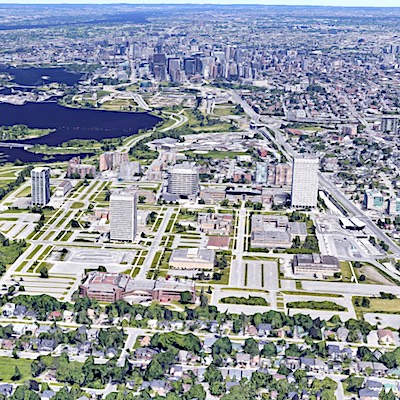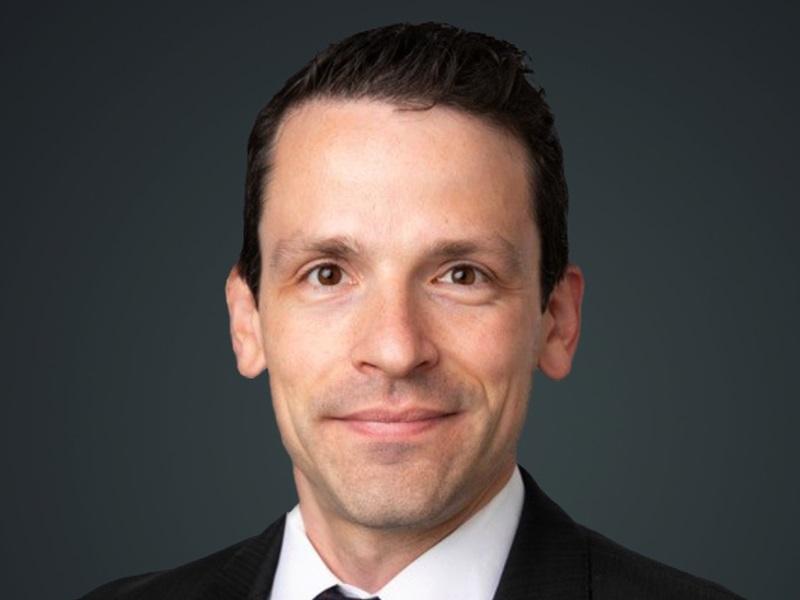
The federal government is accelerating plans to reduce its office footprint in Ottawa-Gatineau and across the country, and compiling a list of properties for redevelopment or divestment, a senior bureaucrat told over 710 commercial real estate professionals at the Ottawa Real Estate Forum.
Speaking during one of the keynote sessions at the Oct. 13 forum, Stéphan Déry reiterated the government’s intention to shed millions of square feet of office space – much of it in Ottawa and Gatineau – and other real property assets.
The COVID-9 pandemic plays a prominent, but not exclusive, role in the updated plans.
“I would like to say we have the answer to everything, that everything is back to normal was it was pre-pandemic. But we don’t have all the answers,” said Déry, assistant deputy minister of real property services for Public Services and Procurement Canada (PSPC).
The department is responsibility for much of the property owned and leased across Canada on behalf of the federal government and its various agencies.
PSPC has been collecting data from departments which have been experimenting with a wide range of back-to-the-office, hybrid work and work-from-home schemes. One of the key aims is to determine how much office space government departments will need in the future.
“Departments have been experimenting over the summer and now we can see starting in September and October they are starting to implement the hybrid model(s),” Déry explained .
42 million sq. ft. in Ottawa, Gatineau
With 42 million square feet of facilities and government-owned or -leased space across the National Capital Region, Déry had the rapt attention of those in the audience.
“At PSPC, for example, we have decided to adopt the hub-and-spoke model, something that has been adopted around the world by multiple governments,” he continued.
“We are not leaders by any means in the future of work, the U.K. were there in 2013, the U.S. is probably five to seven years ahead of us . . .”
Original estimates from previous government workplace initiatives suggested up to 30 per cent of its portfolio (owned and leased) could be shed.
While Déry said it is still too early to provide a precise update, he suggested the feds still want to divest 15 to 20 per cent of their space nationwide.
In Ottawa and Gatineau, that means about six to eight million square feet of space during the next decade, providing the plan doesn’t change again.
He also said more concrete information will be available in coming months following an updated usage inventory.
“It’s a good opportunity for us to look at our portfolio and say ‘OK how many buildings are past due date? Instead of capitalizing them, we should dispose of them.’
"I’m hoping that within the next couple of months I’ll be able to publicly release a list of buildings that the federal government intends to dispose of in this city,” Déry said.
“We’re not going to sell them all together, but we are planning to dispose of a significant portion of our assets that are behind, that we won’t recapitalize and that somebody else, a developer, can buy them and redevelop them.
"The idea behind that is really working with the City of Ottawa and the City of Gatineau to give them an idea of what is happening in the next 10 years.”
“It gives a good opportunity for industry, developers, the city to look at what we are going to be disposing and saying here’s opportunity.”
More modern, sustainable and accessible facilities
Aside from the timeline, the divestment plans remain largely in line with what the feds have been proposing for several years.
“Before the pandemic we had produced our office long-term portfolio plan and in that portfolio plan we were talking about a reduction of portfolio across the country, not just Ottawa, of 30 per cent over 25 years,” Déry said.
“Even before the pandemic we were trying to move toward the activity-based workplace, for the last four or five years. The pandemic has just accelerated that.”
The existing government mandate for accessible, sustainable and attractive workspace will play a major role in what gets retained and what is divested or not renewed.
“The cubicle farms that we see in office buildings . . . rows and rows and rows of them, that is not what people are looking for,” he said.
“People want to see green buildings, they want to see accessible buildings, so there’s opportunity for us to move that portfolio we have across the country and also in the National Capital Area, to a new portfolio; new space, attractive space.”
Responding to a question from interviewer Nathan Smith (executive vice-president and managing director, capital markets, for Cushman & Wakefield in Ottawa), Déry said the government has renewed $1.1 billion in leases during the past 18 months while already shedding some excess space.
That equates to 69 leases and over eight million square feet of space.
“We are not walking out of the market, we are continuing to assess our needs and continuing to renew leases and work with the industry,” Déry said.
However, not all of those leases were for long terms. PSPC is balancing the widely varying needs of its many departments with the quality of the spaces they occupy.
“I do renew leases for a year, I do renew leases for five years, sometimes for 10 years, but don’t expect that my leasing team is going after all the leases to see which ones they are going to cancel, or as they come up we are going to cancel them all,” Déry said.
Potential for new developments
The federal government is also considering whether to move some departments into space vacated by other departments which have longer-term leases remaining, or into higher-quality accommodations to retain talent and fulfill its update priorities.
“How the existing building meets the government’s priorities; greening, accessibility, indigenous reconciliation, these are government priorities,” he noted.
“So if I have a green building that I am in, and I can see over the future, maybe I will want to stay in a carbon-neutral building.”
The feds are also updating, or in the initial stages of co-developing, a number of major properties in Ottawa. After another question from Smith, who mentioned several sites including Tunney’s Pasture, or a new campus proposal along Tremblay Road, Déry said these projects have not been shelved, but some have been “put on the back burner for now.”
Offering one example, he said the feds are continuing to assess the future of campuses such as Tunney’s Pasture, a major government hub just west of the downtown core, overlooking the Ottawa River.
“Really we want to creates nodes that are work, live, play. Instead of having a Tunney’s Pasture that is all office buildings, you have a Tunney’s Pasture that has multi-use properties,” he explained.
The Tremblay Road proposal adjacent to a transit node just east of downtown, is also continuing to move forward, he said.
“Tremblay is one of these projects … it’s a project where we were looking for a lease-leaseback of 150,000 square metres. I can’t talk much about it because the RFPs have been received and they are in technical evaluation right now.
“It’s still on the way.”










